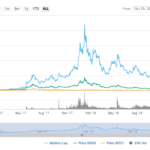
What Is a Crypto Market Cap?
Cryptocurrency market capitalization is a metric resulted from a mathematical calculation which determines what value a cryptocurrency has on the market.
Various crypto sites that track prices, such as CoinMarketCap, rank the coins in the descending order according to their market cap.
Today we will be delving deep into what market cap is, how it works and how it can be applied in investment strategies.
Calculating a Cryptocurrency’s Market Cap
The Market cap of a coin is calculated using a mathematical formula:
Market cap = Total Circulating Supply * The coin’s price.
As you can see, the market cap of a coin is resulted by multiplying the coin’s circulating supply with the price of each coin.
If “X Coin” has a circulating supply of 500,000 coins and each coin has a price of $1, then X Coin’s market cap will be 500,000*1 = $500,000.
Also, if “Y Coin” is worth $2 and has a circulating supply of 50,000 coins, then its market cap will be 50,000*2 = $100,000.
 Image source: on GuruTrade
Image source: on GuruTrade
However, even if an individual Y Coin has a higher value than an X Coin, the overall value of X Coin is much bigger than Y Coin. This is why market cap better reflects a project’s value rather than the price of its individual coin.
In the case of EOS and Litecoin, both of them have similar market caps. But EOS ranks higher, even though it is trading at $6.27 while Litecoin is trading at $96. This is because EOS has a circulating supply of 912,910,017 while Litecoin has 61,911,251.
Market Cap Classification
By knowing the market cap of coins, investors can estimate the risk they are exposing themselves to when selecting a crypto for their portfolio.
A broad classification of cryptocurrencies would consist of three categories: “large-cap”, “mid-cap” and “small-cap”.
- Large-cap cryptocurrencies have a market cap that is above $10 billion. These companies or projects are considered to be safe investments, as even in times of extreme fluctuation they still have higher values. According to data from tracking sites, only Bitcoin, Ripple, and Ethereum fall into the category of large-cap coins.
- Mid-cap cryptocurrencies have a market cap situated between $1 billion and $10 billion. These coins come with a higher degree of risk compared to large-cap cryptos. Several mid-cap cryptos are Litecoin, EOS, Bitcoin Cash, Cardano, Tether, TRON, and Stellar.
- Small-cap cryptocurrencies have the smallest market cap out of the group and, as a result, they have the highest risk of failure. Coins that have a market cap under $1 billion are considered to be small-cap.
Risk and Profit
Large-Cap
Investing in a crypto that has a large-cap will most likely not bring you any sudden profits or high price swings. It is because these cryptos fluctuate less compared to their peers, which makes them a “safer” investment. While you will not be seeing any major gains, your investment may still experience some minor growths.
Cryptocurrencies have a higher volatility compared to traditional stocks. This means that large-cap cryptos still have a higher possibility of bringing gains than large-cap shares.
Mid-Cap
While mid-cap cryptos have a lower market-cap, they have a lot more potential to grow than their large-caps sisters. This is because they haven’t reached their full potential and they may be still in the process of expanding their market or use cases. But, at the same time, they can also depreciate even more, that is why they are riskier.
Small-Cap
Low market cap cryptos are predisposed to follow the market wild fluctuations. One day you might see some substantial rises and, in the next minute, you might see your investment plummet to near zero.
But, if they are so risky, why invest in them at all? Well, this is because they might have the potential to increase exponentially in value and generate much larger profits compared to large-cap or mid-cap cryptos. Keep in mind that Ethereum began trading at less than a $1 and now is one of the larger-cap coins.
Additional Factors That Should Be Considered
Dead Coins
The true market cap of a coin can be influenced by how many dead coins are on the market. Dead coins are those that cannot be used or accessed anymore due to certain reasons (for example, the coins that are held in a wallet that has been lost or whose recovery password has been forgotten). There are also bugs in the blockchain code, which can lock wallets or lose coins. Or the cryptos can be stolen in a hack and they cannot be redeemed.
Due to this factor, a more accurate cryptocurrency market capitalization should be calculated like this:
 Image source: eBay
Image source: eBay
Cryptocurrency Market Cap = (Total Circulating Coins – Dead Coins) * Coin’s Individual Price
However, there is no way of knowing exactly the number of dead coins.
Market Manipulation
Another factor that should be taken into account when looking into cryptocurrency market capitalization is market manipulation. Small market caps can be exploited and used to pump prices more easily than large caps. This is done by several bad actors who control a large size of the total supply of a small market cap coins, to generate large price increases or depreciation.
Final Thoughts
There are various tools that investors can use in order to determine what coin can turn out to be a profitable or safe investment. Cryptocurrency market capitalization is one of such instruments. But do keep in mind that you shouldn’t rely on market cap alone to make an investment decision.

coindoo.com is author of this content, TheBitcoinNews.com is is not responsible for the content of external sites.
Our Social Networks: Facebook Instagram Pinterest Reddit Telegram Twitter Youtube










